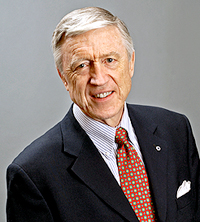Contributor: Sathvik Ramanan
Work and Life is a radio program hosted by Stew Friedman, director of the Wharton Work/Life Integration Project, on Sirius XM’s Channel 111, Business Radio Powered by Wharton. Every Tuesday at 7 pm EST, Stew speaks with everyday people and the world’s leading experts about creating harmony among work, home, community, and the private self (mind, body, and spirit).
On Work and Life, Stew Friedman spoke with Dr. John Kimberly, Professor of Management, Entrepreneurial Management, and Health Care Management at The Wharton School. He is also a distinguished visiting scholar at INSEAD, Penn’s partner school in France. Professor Kimberly received his BA at Yale and his MS and PhD at Cornell. Friedman spoke with Kimberly about how changes in healthcare as a profession are affecting not just healthcare professionals, but all of us.
The following are edited excerpts of their conversation.
Stew Friedman: How did you first get into studying healthcare as an industry?
John Kimberly:  There’s an easy answer to that question Stew. I wrote my dissertation a little more than 30 years ago when I was a doctoral student at Cornell University. I was in a program in organizational studies, and serendipitously a faculty member with whom I was working closely got a big grant from the National Institute of Health to study the diffusion of innovations to hospitals. That was a project that I was fortunate enough to be involved in. I actually wrote my dissertation on data we collected from that study, and it turns out, at least in my case, that you become what you write. I started writing more about hospitals and innovation, and invitations to speak and consult and so on began to emerge from that. There was a bit of a tipping point there, where the kind of opportunities that were coming my way were largely in healthcare, and so I ultimately picked up that ball and ran with it.
There’s an easy answer to that question Stew. I wrote my dissertation a little more than 30 years ago when I was a doctoral student at Cornell University. I was in a program in organizational studies, and serendipitously a faculty member with whom I was working closely got a big grant from the National Institute of Health to study the diffusion of innovations to hospitals. That was a project that I was fortunate enough to be involved in. I actually wrote my dissertation on data we collected from that study, and it turns out, at least in my case, that you become what you write. I started writing more about hospitals and innovation, and invitations to speak and consult and so on began to emerge from that. There was a bit of a tipping point there, where the kind of opportunities that were coming my way were largely in healthcare, and so I ultimately picked up that ball and ran with it.
SF: You’ve seen a lot of changes as the world of healthcare management has been radically transformed. Let’s start with a picture of the current state of things: What’s most distinctive and unique about healthcare today vs 30 years ago?
JK: The changes have been considerable and profound. Obamacare, the Affordable Care Act, is just the tip of the iceberg. I think what has changed has to do with the nature of contact and interaction between us patients and the healthcare professionals. It has to do with organizational arrangements that are changing rapidly. It has to do with the introduction of a vast number of clinical innovations. One of the most exciting things for me is how we’re finally beginning to move the needle on prevention. We´re beginning to focus on community-level health outcomes and the wellbeing of communities as opposed to the medical care of individual people.
SF: Can you define what you mean when you say prevention?
JK: If you look at this country’s healthcare system, you´ll find that the vast majority of expenses are on medical care; we call it ¨healthcare ¨ but what it really is is medical care. It’s interventions that are made by professionals in the medical care system to deal with the problems of people who have gotten sick. Think about a world in which there was investment in prevention at even one-quarter of the magnitude of the investment in medical care, a world where the incentives were to keep people healthy, to keep people out of the hospital. Think about the kind of investments it would take at a community level to make sure people are healthy. It’s beginning to happen.
SF: What’s been most significant about how the work of medical professionals, doctors in particular, has changed, and why is that important for us as consumers?
JK: I think the most profound change has been the shift from the solo practice, where physicians were individual entrepreneurs and managed their own practices, to a model where increasingly physicians are becoming employees of large healthcare systems. What they’ve traded off is the independence and autonomy that they enjoyed when they were individual entrepreneurs for a life which is dominated by productivity targets and other things which essentially impinge on their ability to make independent decisions on how they spend their time.
SF: Not to mention their own diagnosis and intervention choices, right?
JK: Those are obviously constrained by the system in which they work. There are guidelines for the kind of equipment they use and the kind of clinical context in which they work. What’s really important is the disruption of the historic physician-patient relationship.
Forty years ago, when you got ill and called your physician, at some point in the next five or six hours, there’d be a knock on the door. The physician would be there with his or her little bag and would ask some questions and would look you in the eye and would give you what you needed in order to get you better. A part of that healing process was the personal relationship between the physician and the patient. Now, that process is much more technically-based, and physicians, who are employed by these large systems, have production quotas to meet. The time they spend with their patients is not in eye-to-eye contact because the physician has to be looking at his/her keyboard to enter data into the health information system. So there’s something fundamental that’s changed about the relationship between the doctor and the patient. Now, some people will say, “Well, of course, this is the nature of things. There’s been technological progress, and physicians are now able to see more patients in less time, so the efficiency is enhanced substantially.” There’s certainly some truth to that. However, I also believe that in the course of moving down this path, we’ve lost something important. One of the interesting issues here (the answer to which we still don’t know) is the question of how much of the healing process is a function of technical interventions versus how much of it hinges on a relationship that you develop with someone who you trust and who you think has a personal interest in you. This is an interesting area of research, and by no means are the answers in on that score.
SF: Wow, so that is an important question. You’re saying that it’s a topic that hasn’t gotten a lot of attention in the research literature on healthcare outcomes?
JK: That’s exactly right. It´s understandable. Why? Because in the fascination for technological progress, the focus has really been on what’s the latest, greatest, shiniest, new technology that we can bring into the system that will have both financial impact and health outcome impact. I think what’s happened along the way is this other part of a doctor-patient relationship has gotten lost.
Join Work and Life next Tuesday at 7 pm on Sirius XM Channel 111. Visit Work and Life for a full schedule of future guests.
To learn more about Professor John Kimberly and his research click here.
About the Author
Sathvik Ramanan  is an undergraduate freshman in the Vagelos Program in the Life Sciences and Management at the University of Pennsylvania.
is an undergraduate freshman in the Vagelos Program in the Life Sciences and Management at the University of Pennsylvania.
Leave a Reply